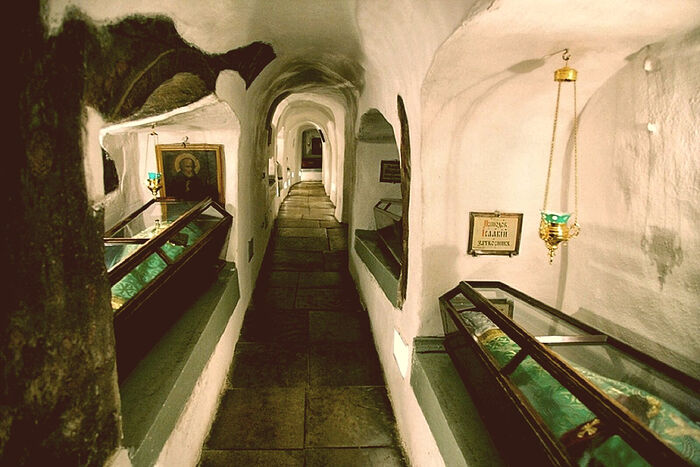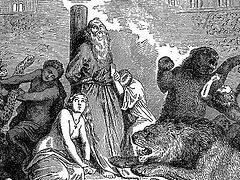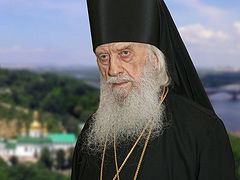March 13. The beginning of the third week of Great Lent. A video of the distribution of books in the Lavra, which I dare to call my home, falls into my hands. Compared with the other well-known sad events of recent weeks it is an insignificant episode. The library is distributing its property, which has been carefully collected and stored. Empty shelves, a small queue of pious laywomen and seminarians. Someone is walking among the shelf stands, which have already lost a good many of books. Books are being distributed to prevent them from becoming ownerless so that they can continue to serve their great purpose.
In the midst of this bustling evening I can see the long-standing head of the library; with his own hands this monk is helping others sort out the property of the library entrusted to him. A distressing sight, albeit one of a number of similar ones. It causes acute anguish in the soul. And not just out of sympathy... I used to know this library when it was different. For example, here's the bookcase to which I myself would come and look for books for my bachelor’s thesis. There were excellent and very rare editions on the twentieth century theological thought. A little further away is a shelf stand with unique books printed before the Revolution—mostly liturgical books. They had a special smell of sacred antiquity. In the video these shelves are already empty—a seminarian is examining some lonely little book huddled up in a corner. The monks may have already taken the other books to the skete or have distributed them. The camera pans around—in the same place, in the semicircle of windows, is the table at which I once wrote with inspiration. I remember these moments as if it were yesterday—the Kiev autumn weather and the Lavra side-streets in the yellowing greenery could be seen through the windows. We could see domes and crosses. Silence reigned in the library. Near us were books that we could freely take off the shelves, look through, choose what we needed and even take some book to our “cells”—that’s what we called the rooms in the seminary dormitory. My first thesis—I wanted to write about everything, feeling a special creative impulse. It was so great to build book thoughts into one harmony of your own composition!
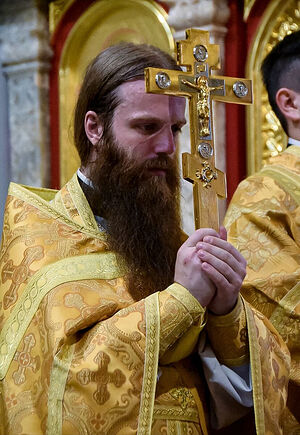 Archimandrite Silouan (Pasenko) The video ends, and with it my memories. The Lavra left so much in my soul, even through such tiny episodes! Will it lose its vivifying, sanctifying and edifying property with the coming of the militant atheists? Will it leave history as a temporary phenomenon? I believe it won’t. This is the eternal earthly domain of the Theotokos. As the Lavra aphorism goes: “The monastery is in the caves.” The monastery lives thanks to the incessant prayers of its venerable fathers. Through Heavenly intercessions the Lavra will overcome discord, as evidenced by its 1000 years of history. For me there is another argument for the inviolability of the sacred essence of the Kiev-Caves Monastery. It was prompted by seven years of life at the monastery, the fruit of which was my monastic tonsure.
Archimandrite Silouan (Pasenko) The video ends, and with it my memories. The Lavra left so much in my soul, even through such tiny episodes! Will it lose its vivifying, sanctifying and edifying property with the coming of the militant atheists? Will it leave history as a temporary phenomenon? I believe it won’t. This is the eternal earthly domain of the Theotokos. As the Lavra aphorism goes: “The monastery is in the caves.” The monastery lives thanks to the incessant prayers of its venerable fathers. Through Heavenly intercessions the Lavra will overcome discord, as evidenced by its 1000 years of history. For me there is another argument for the inviolability of the sacred essence of the Kiev-Caves Monastery. It was prompted by seven years of life at the monastery, the fruit of which was my monastic tonsure.
For me life in the Lavra began with the seminary. It was not easy, but, as you can judge today, it was an extremely important experience. The first year of my life within the monastery walls was accompanied by endless temptations. Obediences were very hard to handle; the work seemed extremely difficult and distracted from classes. I was often sick. One autumn evening I came down with pneumonia and then sinusitis. The seminary administration was going to send me on a sick leave, but somehow I managed to continue my studies. Needless to say, the life of the monastery seemed to be going past me. Although I attended the Lavra services and even some monastic events, my comprehension of them did not keep pace with the swift passing of time.
Trials and tribulations continued for the next two years. They became decisive—for the first time, the question of a choice in spiritual life arose acutely: Whether or not I would be able to act as a Christian, overcoming anger, pride and resentment. It was akin to the temptation that Patriarch Pavle of Serbia once wrote about. During his seminary years, as I learned later, he had an innermost question, without an answer to which he could have left the seminary. And yet he found an answer. An answer to pain and torment came to me at a small monastic cemetery beside the Church of the Nativity of the Most Holy Theotokos. It was built on the site of the first wooden church of the Kiev Caves Monastery (in the Far Caves). The stars could already be seen in the sky, and there were clarity, comfort and peace inside me. Until the end of my stay in the monastery I never got sick again. And the one who had caused my trial disappeared from sight. Literally disappeared.
In the same year the Lord sent me a father-confessor. I was happy. At the same time, my legs stopped hurting during services—I was less and less distracted. However, life still did not differ from what was generally accepted at the seminary: ordinary and obligatory services, obediences, visits to the Caves of the venerable fathers, sorties into the city and communication with peers. Moreover, the goal of everything seemed to be the pastoral ministry as a married priest—in no way monastic life. It was repeatedly voiced in communication with my closest friend—another gift sent by the Lavra and the seminary through my parents’ prayers. However, at the same time, my father-confessor blessed me to study the Life of St. Silouan of Mt. Athos, which, together with the Ancient Patericon, became my favorite literature. Another consolation was a trip arranged by the Academy to the Holy Land, to Jerusalem, for Pascha.
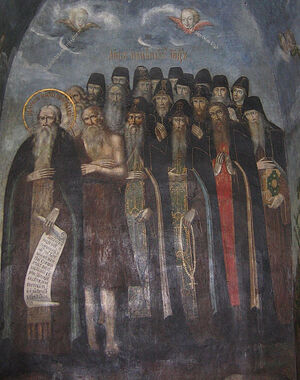 Fresco in the Kiev-Caves Lavra The final, fourth year at the seminary. At that wonderful time, I was writing my bachelor’s thesis and familiarizing myself with the Lavra’s library. At the same time, I did not make any broad acquaintances with the monastery brethren and indeed did not even seek that. I more and more wanted to go to the relics of St. Gregory the Wonderworker in the Far Caves. It was to his shrine in the corner behind the cave church that I went. Knowing the custom of greeting the saints with the words, “Christ is Risen!” I did that. It turned out that prayer at the shrine became like a conversation. The saint silently listened to everything. In that year, in those moments, an uplifting feeling and joy prevailed in my soul. I was able to go to confession more often. The Lord sent me the obedience of teaching catechism courses at the Lavra. It was an amazing sight: At the end of their work day, people would come to the monastery to devote several hours to their classes until late in the evening. There were twenty to thirty people in one cramped lecture room. And there were several such groups simultaneously. I remember the eyes of those people—their genuine interest, their longing for the Church. They were a lesson to me. So the academic year went on, and with it the seminary life... When I went on vacation, I began to catch myself thinking that I didn’t want to leave the Lavra.
Fresco in the Kiev-Caves Lavra The final, fourth year at the seminary. At that wonderful time, I was writing my bachelor’s thesis and familiarizing myself with the Lavra’s library. At the same time, I did not make any broad acquaintances with the monastery brethren and indeed did not even seek that. I more and more wanted to go to the relics of St. Gregory the Wonderworker in the Far Caves. It was to his shrine in the corner behind the cave church that I went. Knowing the custom of greeting the saints with the words, “Christ is Risen!” I did that. It turned out that prayer at the shrine became like a conversation. The saint silently listened to everything. In that year, in those moments, an uplifting feeling and joy prevailed in my soul. I was able to go to confession more often. The Lord sent me the obedience of teaching catechism courses at the Lavra. It was an amazing sight: At the end of their work day, people would come to the monastery to devote several hours to their classes until late in the evening. There were twenty to thirty people in one cramped lecture room. And there were several such groups simultaneously. I remember the eyes of those people—their genuine interest, their longing for the Church. They were a lesson to me. So the academic year went on, and with it the seminary life... When I went on vacation, I began to catch myself thinking that I didn’t want to leave the Lavra.
Then the masters course. Two years after seminary—the fifth and the sixth years of life in the monastery. It so happened that I became a subdeacon and began to work at the Kiev Metropolia. It was a turbulent time—the “Maidan” revolution of 2014. I remember how, while carrying out my obedience at the Information and Education Department, I had to fight tons of mud aimed at the Church on the internet. I would get up early, at four in the morning, then make lecture notes with inspiration, then attend services at the Lavra and in the city. It seemed amazing to pray in the Cave churches, sanctified by the prayers of the venerable fathers. These are the most vivid memories of that time. I developed the custom of addressing each saint from the Caves in prayer, as earlier I had addressed the Venerable Gregory. Their names were imprinted on my memory: “St. Nestor, not the Chronicler, improve my spiritual literacy!” “Father Zeno the Faster, teach me to fast!” I remember services in the Refectory Church by the warmth of the walls, the prayerful spirit, Russian church architecture, and marvelous monastic and student choral singing. I got acquainted with the abbot, a very pious and caring pastor, and some brethren through work. However, my communication with fellow students at the Academy was no less active. I was vouchsafed to visit Mt. Athos with them for the first time. I could feel a special Providence in everything. The awareness of the importance of obediences, physical labor, the rule and especially of prayer came. By that time, I had received the blessing to pray with a prayer rope, although I didn’t regard it as preparation for my monastic tonsure, but as a useful activity. The Lavra was imprinted on my memory as a loving mother. It provided all that I needed, and always at the right time. However, I would like to make an admission: Life in the monastery was combined with sorties to the outside world. At that time, my correspondence course at the university impelled me to do so willy-nilly. Incidentally, it was with a blessing—another important lesson of life in the monastery.
My postgraduate studies. The first year and seven years of life in the monastery. Of course, during this time there were vacations and trips outside the monastery, and yet every year they became shorter and shorter. The question arose whether I would fully devote myself to serving in the Church if I got married. I had already traveled with it several times to Mt. Athos and asked the venerable fathers of the Caves. I received an answer and asked the question again. However, this question did not pose a problem, as it is now becoming clear. It needed careful rechecking and honesty. The tonsure was performed in the Far Caves—several academy students were tonsured. They did not choose their names; they knew the custom that tonsure, although performed in a monastery, followed the academy’s tradition of naming graduates in honor of its saints. I heard the name “Silouan” over me—in honor of St. Silouan of Mt. Athos. It was an exception to the rule on the occasion of the 1000th anniversary of Russian monasticism on Holy Mount Athos. I had the joy of being ordained in the Exaltation of the Cross Church of the Lavra, where the brethren usually pray. I served forty Liturgies at the monastery with the monastics. I will not forget the kindness of the clergy, who received us as their brothers. It is noteworthy that I sang my first Akathist to the Dormition of the Most Holy Theotokos as a hierodeacon in tandem with another hierodeacon. He turned out to be the same person who had been the cause of severe temptations in the first years of my life in the Lavra. The monastery erased the sharp corners of egotism and by God’s Providence arranged everything in the best possible way.
Although by the will of God I nevertheless had to leave the Lavra for my pastoral ministry, I feel that I am it’s student—from the first harsh lessons of obedience to the joy of prayer in the altar of the Cave church or the Dormition Cathedral. The monastery is very vividly seen as the cradle of monasticism, an earthly domain of the Mother of God, which embodies Divine Providence in unfathomable ways. The Lavra is a spiritual phenomenon that didn’t appear by human will, but by the God’s will; and will exist according to its spiritual laws in spite of all worldly vanity. In the Lavra you can see an all-conquering power capable of influencing the most impregnable stronghold of a human being—his heart. For this reason I am convinced and believe that the spiritual monastery, the one in the Caves, cannot be taken away from the Church, closed or buried. God willing, if we are found worthy, we will be vouchsafed a greater glory of the venerable fathers even in our time on the Kiev hills, for the Gospel words are immutable: Blessed are the meek, for they shall inherit the earth (Mt. 5:5).

